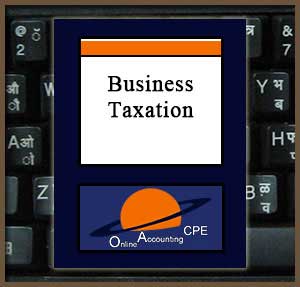Business Taxation 2022 - 24 CPE Credit Hour
Americans who want to be their own boss are not entirely on their own. They have a rich uncle - Uncle Sam - who is there to help, as well as to make demands. The nation's tax laws are intended to encourage people to start new businesses and are chock full of incentives and tax breaks, as well as sometimes onerous reporting requirements.
This course is a fast-paced and entertaining guide through tax issues affecting business entities and their owners. The focus of this class is on tax devices and techniques available to the small-business owner. Emphasis will be given to operational deductions, fringe benefits, compensation, family income splitting, retirement plans, and estate planning.
Completion Deadline & Exam: This course, including the examination, must be completed within one year of the date of purchase. In addition, unless otherwise indicated, no correct or incorrect feedback for any exam question will be provided.
Course Level: Overview. This program is appropriate for professionals at all organizational levels.
Field of Study: Taxes
Prerequisite: General understanding of federal income taxation.
Advanced Preparation: None
Learning Assignments & Objectives
As a result of studying each assignment, you should be able to meet the objectives listed below each assignment.
ASSIGNMENT SUBJECT
Chapter 1 Structure, Reporting & Accounting
At the start of Chapter 1, participants should identify the following topics for study:
* Sole proprietorships
* Partnerships
* Regular corporations
* Recordkeeping
* Kinds of records to keep
* Business transactions
* Bookkeeping systems
* How long to keep records
* Accounting periods & methods
* Inventories
Learning Objectives
After reading Chapter 1, participants will be able to:
1. Recognize sole proprietorships, partnerships, and corporations as organizational formats for new and existing businesses.
2. Identify how choice of entity relates to the type of records to keep, listing issues related to substantiation and documentation.
3. Specify available accounting periods and methods and the methods for identifying and valuing inventory items.
After studying the materials in Chapter 1, answer the exam questions 1 to 11.
ASSIGNMENT SUBJECT
Chapter 2 Business Income, Credits & Assets
At the start of Chapter 2, participants should identify the following topics for study:
* Rental income
* Interest
* Discharge of debt income
* Dividends
* Recoveries
* Depreciation recapture
* Partnership income
* Business & investment credits
* Asset types
* Non-recognition transfers
Learning Objectives
After reading Chapter 2, participants will be able to:
1. Identify the various types of income and their implications, including the hidden income tax dangers of cancellation of indebtedness income, tax recoveries, and depreciation recapture.
2. Specify the existing basic business and investment tax credits, naming their tax requirements, and business asset types that affect the character of gain or loss, and recognize the tax treatment on the disposition of business assets, including non-recognition transfers and §1231 assets.
After studying the materials in Chapter 2, answer the exam questions 12 to 18.
ASSIGNMENT SUBJECT
Chapter 3 Selected Business Expenses
At the start of Chapter 3, participants should identify the following topics for study:
* Section 162
* Expenses of not-for-profit activities
* Rent expenses
* Interest expense
* Deductible taxes
* Other selected deductible costs
* Amortization
* Depletion -§613
* Business bad debts
* Depreciation
Learning Objectives
After reading Chapter 3, participants will be able to:
1. Recognize the importance of §162 in deducting and substantiating business expenses and costs and specify the implications of the deduction timing and limits specifying the treatment of not-for-profit activities.
2. Identify conditional sales contracts, leveraged leases, and true leases, and determine how to qualify for rent expense deductions including through leasehold improvements.
3. Specify the various forms of interest expense under §163(a) recognizing related reporting and filing issues, and identify the distinctions between deductible and nondeductible interest.
4. Recognize deductions for real estate, state, and local taxes and list deductions for home office use, research and experimentation costs, barrier removal, and mine development.
5. Identify the various forms of tax treatment under the concepts of depreciation and amortization, including the effect on amortization of §197.
6. Determine the differences between cost depletion and percentage depletion as a means of accounting for the reduction of a product’s reserves.
7. Specify the types of bad debt and their effect on accounting and the various methods for dealing with bad debt.
8. Recall MACRS classifications, cite the recapture provisions and exceptions, and identify the alternative depreciation system.
After studying the materials in Chapter 3, answer the exam questions 19 to 51.
ASSIGNMENT SUBJECT
Chapter 4 Employee Compensation & Benefits
At the start of Chapter 4, participants should identify the following topics for study:
* Wages, salary & pay
* Tests for deducting pay to employees
* Selected types of compensation
* Payroll taxes
* Selected fringe benefits
* Interest-free & below-market loans
* Equity participation
* Advantages of nonqualified deferred compensation
* Funded company account plans
* Segregated asset plans
Learning Objectives
After reading Chapter 4, participants will be able to:
1. Specify the common-law rules used by the IRS to determine whether a person is an employee for purposes of FICA, FUTA and federal income tax withholding.
2. Identify the tests for wages to be deductible and how excluded fringe benefits can result in more employer deductions and incentive-based compensation to employees.
3. Recognize the use of deferred compensation agreements including the basic types of nonqualified deferred compensation, and the tax consequences related to these plans.
After studying the materials in Chapter 4, answer the exam questions 52 to 64.
ASSIGNMENT SUBJECT
Chapter 5 Automobiles
At the start of Chapter 5, participants should identify the following topics for study:
* Apportionment of personal & business use
* Deduction limitations using the actual cost method
* Expensing - §179
* Predominate business use rule
* Auto leasing
* Standard mileage method
* Auto trade-in vs. sale
* Employer-provided automobile
* Nonpersonal use vehicle
* Reporting of an employer-provided automobile
Learning Objectives
After reading Chapter 5, participants will be able to:
1. Identify the apportionment of business and personal use of an automobile, including deduction limitations, and specify the various depreciation methods such as MACRS and §179 expensing.
2. Recognize personal auto leasing, its advantages and disadvantages, and the various kinds of leasing arrangements that can be used, such as closed-end or open-end leases.
3. Recall the standard mileage method listing its limitations and identify the various working condition fringe benefits including their impact on the gross income of employees.
4. Identify the various valuation methods used in determining the actual value of an employee’s personal use of an automobile specifying the reporting options available to the employer.
After studying the materials in Chapter 5, answer the exam questions 65 to 78.
ASSIGNMENT SUBJECT
Chapter 6 Business Travel & Entertainment
At the start of Chapter 6, participants should identify the following topics for study:
* Transportation & travel distinguished
* Definition of “tax home”
* Temporary & indefinite assignments
* Business purpose requirement for business travel
* Conventions & meetings
* Statutory exceptions of the ordinary & necessary requirement
* Post-2018 restrictions on entertainment & facilities
* Employee expense reimbursement & reporting
* Self-employed persons
* Employers
Learning Objectives
After reading Chapter 6, participants will be able to:
1. Identify deductible business travel expenses by:
a. Specifying the differences between transportation and travel in order to benefit from the appropriate business tax deduction;
b. Recalling IRS definitions of a taxpayer's tax home for travel and transportation purposes;
c. Recognizing how time acts as a critical factor in distinguishing a temporary from an indefinite job assignment; and
d. Specify the distinctions between business and nonbusiness days.
2. Determine the factors associated with the business purpose requirement stating how they determine deductible expenses for meals and currently restricted entertainment.
3. Identify the applicable federal per diem rate from any one of several methods and the different reporting and income inclusion treatments given to self-employed persons or reimbursed employees.
After studying the materials in Chapter 6, answer the exam questions 79 to 89.
ASSIGNMENT SUBJECT
Chapter 7 Retirement Plans
At the start of Chapter 7, participants should identify the following topics for study:
* Qualified deferred compensation
* Basic requirements of a qualified pension plan
* Basic types of corporate plans
* Types of defined contribution plans
* Self-employed plans – Keogh
* Distribution & settlement options of IRAs
* Tax-free rollovers for IRAs
* Roth IRAs
* Simplified employee pension plans (SEPs)
* SIMPLE Plans
Learning Objectives
After reading Chapter 7, participants will be able to:
1. Recognize the requirements and characteristics of qualified retirement plans by:
a. Citing the limitations imposed by ERISA and TEFRA;
b. Specifying trust requirements and tests associated with these requirements, such as the ratio test; and
c. Identifying three classes of vesting listing how the vesting standards affect retirement plans.
2. Determine the differences between defined contribution and defined benefit plans recognizing the different types of plans and their effect on retirement benefits.
3. Identify Keogh Plans, traditional and Roth IRAs, and SIMPLE 401(k) plans by specifying their characteristics and determining how and when they may and may not be appropriate.
After studying the materials in Chapter 7, answer the exam questions 90 to 104.
ASSIGNMENT SUBJECT
Chapter 8 Insurance
At the start of Chapter 8, participants should identify the following topics for study:
* Company paid insurance
* Group term life insurance
* Retired li



